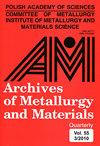Investigation of the Microstructure and Mechanical Properties of Brazing Joints between Niobium and 316L Stainless Steel using Silver-Copper-Palladium Filler
IF 0.7
4区 材料科学
Q4 METALLURGY & METALLURGICAL ENGINEERING
引用次数: 0
Abstract
This paper introduces an approach for vacuum brazing of niobium-316L stainless steel transition joints for application in superconducting radiofrequency cavity helium jackets. The study takes advantage of good wettability of ag-Cu-Pd brazing alloy to suppress brittle Fe-nb intermetallic formation, hence improve the joints’ mechanical performance. The wettability of ag-Cu-Pd filler metal on niobium, the interface microstructure and mechanical properties of the transition joints were investigated. Two kinds of ag-Cu-Pd filler metals had been studied and wet well on the niobium, and the wettability of ag-31.5Cu-10Pd filler metal on niobium was better than ag-28Cu-20Pd filler metal. Microstructure characterization demonstrated the absence of brittle intermetallic layers in all of the joint interfaces. Mechanical properties of samples prepared with ag-31.5Cu-10Pd filler metal were also better than their peers made with ag-28Cu-20Pd filler metal both room temperature (300 K) and liquid nitrogen temperature (77 K). The transition joints displayed shear strengths of 356-375 MPa at 300 K and 440-457 MPa at 77 K, respectively. after undergoing ten thermal cycles between the room temperature and the liquid nitrogen temperature, the transition joints’ leak rates were all lower than 1.1×10 –11 mbar·L/s. Therefore, ag-Cu-Pd filler metal is applicable to high vacuum vessels used at cryogenic temperatures.使用银铜钯填料研究铌与 316L 不锈钢钎焊接头的微观结构和机械性能
本文介绍了一种用于超导射频空腔氦气套的铌-316L 不锈钢过渡接头的真空钎焊方法。该研究利用 ag-Cu-Pd 铜焊合金良好的润湿性来抑制脆性 Fe-nb 金属间化合物的形成,从而改善接头的机械性能。研究了 ag-Cu-Pd 填充金属对铌的润湿性、过渡接头的界面微观结构和机械性能。研究发现,两种 ag-Cu-Pd 填充金属在铌上的润湿性良好,其中 ag-31.5Cu-10Pd 填充金属在铌上的润湿性优于 ag-28Cu-20Pd 填充金属。显微结构表征表明,所有连接界面都不存在脆性金属间层。使用 ag-31.5Cu-10Pd 填充金属制备的样品在室温(300 K)和液氮温度(77 K)下的机械性能也优于使用 ag-28Cu-20Pd 填充金属制备的样品。在室温和液氮温度之间经过十次热循环后,过渡接头的泄漏率均低于 1.1×10 -11 mbar-L/s。因此,ag-Cu-Pd 填料金属适用于在低温条件下使用的高真空容器。
本文章由计算机程序翻译,如有差异,请以英文原文为准。
求助全文
约1分钟内获得全文
求助全文
来源期刊

Archives of Metallurgy and Materials
工程技术-冶金工程
CiteScore
1.20
自引率
0.00%
发文量
0
审稿时长
4.5 months
期刊介绍:
The Archives of Metallurgy and Materials is covered in the following Institute for Scientific Information products: SciSearch (the Science Citation Index - Expanded), Research Alert, Materials Science Citation Index, and Current Contents / Engineering, Computing and Technology.
Articles published in the Archives of Metallurgy and Materials are also indexed or abstracted by Cambridge Scientific Abstracts.
 求助内容:
求助内容: 应助结果提醒方式:
应助结果提醒方式:


